Mineral Resources
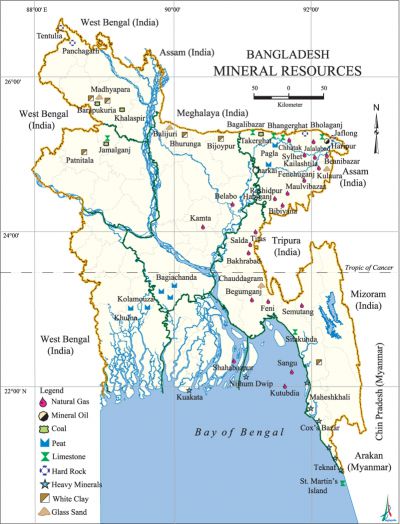
Mineral Resources mineral reserves plus all other deposits that may eventually become available - either known deposits that are not economically or technologically recoverable at present, or unknown deposits, rich or lean, that may be inferred to exist but have not yet been discovered. Geologically, Bangladesh occupies a greater part of the bengal basin and the country is covered by Tertiary folded sedimentary rocks (12%) in the north, north eastern and eastern parts; uplifted Pleistocene residuum (8%) in the north western, mid northern and eastern parts; and Holocene deposits (80%) consisting of unconsolidated sand, silt and clay. The oldest exposed rock is the Tura Sandstone of Palaeocene age but older rocks like Mesozoic, Palaeozoic amid Precambrian basement have been encountered in the drill holes in the north western part of the country.
Because of a different geological environment, important mineral deposits of Bangladesh are natural gas, coal, limestone, hardrock, gravel, boulder, glass sand, construction sand, white clay, brick clay, peat, and beach sand heavy minerals. Tertiary Barail shales occurring within the oil and gas windows have generated natural gas and oil found in Bangladesh. After generation, gas and oil have migrated upward through multi-kilometre rock layers above, to reach and accumulate in suitable sandstone reservoirs in the Neogene Bhuban and Bokabil rock units. Gravel, glass sand, construction sand, peat, and beach sand are found in the Holocene sediments, and white clay (kaolin) is found in the late Pleistocene sediments in the small hills mainly in the northern part of the country. White clay and glass sand deposits have also been discovered in the north-western part below the surface. Exploitation of the deposits of limestone, construction sand, gravel, glass sand, white clay and beach sand are done through small scale quarrying. The subsurface white clay and glass sand deposits have not been mined yet. Developments of subsurface coal and hardrock mines are going on.

Oil and gas There are 23 discovered gas fields in Bangladesh of various sizes. The estimated recoverable proved and probable (P1+ P2) reserve of the 23 gas fields is 21.05 TCF. Out of which, as of June 2009, a total of 8.37 TCF gas has already been produced and as such the left over proved and probable (P1 + P2) recoverable reserve is 12.68 TCF. Gas in most of the fields is dry, in a few fields it is wet, with considerable amounts of condensate, eg at Beanibazar (16 bbl/mmcfg), Jalalabad (15 bbl/mmcfg), and Kailashtila (13 bbl/mmcfg). Currently, natural gas accounts for more than 75% of the total commercial energy consumption and the major part of the future energy demand would be met from it.
Power sector ranks the highest (52%); fertiliser sector ranks the second (28%); and industry, domestic, commercial and other sectors together rank third (20%) in gas consumption. Currently 17 gas fields under public and private sectors are in production with gas supply between 2000 mmcfg per day.
The only oilfield of the country has been discovered at Haripur in 1986. It has an estimated in-place oil reserve of about 10 million barrels, with a recoverable reserve of about 6 million barrels. The oil field produced 0.56 million barrels of oil in six and a half years, but production remained suspended from 1994.
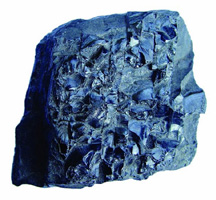
The Haripur oil field has not been fully evaluated and it has been suggested that there is scope for full-scale exploitation after proper appraisal work is carried out. Crude oil bearing reservoir horizons were also found in Kailashtila and Fenchuganj gas fields but these are yet to be proved commercially viable. A number of international oil companies (IOC) are working in Bangladesh for hydrocarbon exploration. Bangladesh Petroleum Exploration Company (BAPEX), an enterprise of petrobangla, the only local company, has been working with success.
Coal first discovered in the country by Geological Survey of Pakistan (GSP) in 1959 was at great depth. geological survey of bangladesh (GSB) continued its efforts for exploration that resulted in the discovery of 4 coalfields. BHP Minerals, a US-Australian company, discovered a field in 1997 totalling 5 coalfields. All the discovered fields lie in the north-western part of the country. Details of the coalfields and quality of the coal are shown below.
Table 1 Coalfields and coal quality.
| Coal field | Depth (m) | Thic kness (m) | Area (sq km) | Reserve (m ton) | Fixed carbon (%) | Volatile matter (%) | Ash content (%) | Sulphur content (%) | Calorific value content (%) | BTU/lb |
| Jamalganj | 640-1158 | 64 | 11.06 | 1053 | 47 (av) | 38 (av) | 22 (av) | 0.62 (av) | 11000 (av) | |
| Barapukuria | 129-506 | 51 | 5.25 | 300 | 45.5-54.7 | 2.28-3.60 | 11.79-23.71 | 0.43-1.33 | 10547-12529 | |
| Khalaspir | 257-483 | 50 | 12.56 | 143 | 32.0-80.8 | 2.93-30.47 | 7.6-50.51 | 0.24-3.15 | 7388-13880 | |
| Dighipara | 328-407 | 61 | Not determined | Not determined | 51.3-65.6 | 25.29-38.23 | 2.64-20.05 | 0.51-1.02 | 10200-14775 | |
| Phulbari | 151 | --- | --- | 386 | --- | --- | --- | --- | --- |
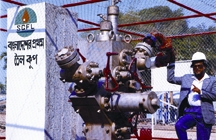
Commercial coal production at Barapukuria Coal Mine started in April 2003 with the expectation to produce 1 million short tons of coal/year (Mmst/y). But the mine produces less than 1 m ton coal/annum and the co-located 250 MW plant consumes 0.65 m ton of coal/year. Leaving 2.35 m ton for domestic users. Coal has been playing vital role in irrigation as well as demand of electricity in North-Western part of the country. Some coal is also being used in brickfields.
BHP Minerals have discovered the Phulbari coalfield in January 1997. The right has later been transferred to an Australian company, Asia Energy Corporation (AEC), to develop the mine. AEC is now working for a detailed feasibility study for open-pit mine development whose initial annual production will be 2.9 million ton that will later be 9 million ton.
Coal imported from India, China, and Indonesia is mainly consumed in brickfields both in public and private sectors, and in small industries.

Limestone In the early 1960s, a quarry of limestone of Eocene age with a small reserve at Takerghat in the north eastern part of the country started supplying raw materials to a cement factory.
This was the first mine in the country which was actually a quarry. In the 1960s GSB discovered another limestone deposit in Joypurhat at a depth of about 515-541m below the surface with a total reserve of 100 million ton. GSB continued its effort to find out limestone deposits at shallow depth. In the mid 1990s GSB discovered limestone deposit at a depth of 493-508 and 531-548m below the surface at Jahanpur and Paranagar of Naogaon respectively. Thickness of these deposits is 16.76m and 14.32m respectively.
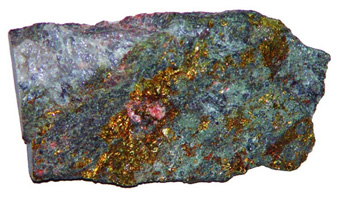
Hard Rock Bangladesh has dearth of construction materials. A large deposit of granodiorite, quartz diorite, gneiss of Precambrian age has been discovered by GSB at depths ranging from 132 to 160m below surface at Maddhyapara, Dinajpur. The Rock Quality Designation (RQD) of fresh rock varies from 60% to 100%. Development of this underground hard rock mine is going on by Nam Nam Co, a North Korean company. Maddhyapara Granite Mining Company Limited (MGMCL), finally went into production 25th mat 2007 after missing several deadlines in about a decade.
Hardrock has been extracted upto April 2007 a sum of total of 459,283.98 metric ton 392030.78 M. Ton of hardrock have already been sold to different organisations. These rocks are used as construction materials for housing apartments, commercial buildings, roads and highways, bridges, dams, river dykes, embankments, flood control, railway ballast and sleepers, decoration pieces, tiles etc.
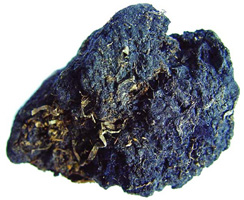
Peat In Bangladesh peat deposits occur in the marshy areas of the north-eastern, middle and south western parts with a total reserve of more than 170 million ton. Calorific value of peat ranges from 6000 to 7000 BTU/lb. Peat can be used as fuel for domestic purposes, brick manufacturing, boilers etc. However, their exploitation has not yet been started. Details of the peat deposits are given in the following table.
Table 2 Peat deposits and quality.
| Deposits | Depth (m) | Thickness (m) | Area (sq km) | Reserve (m ton) | Carbon content (%) | Ash content (%) | Moisture content (%) | Volatile content (%) |
| Bagiachanda | 0-4 | 0.6-3.3 | 500 | 150 | 24 | 16.63 | 17.1 | 42.30 |
| Kolamouza | 0.04-2.5 | 0.2-4 | 25 | 8 | 29.2 | 24.80 | 13.70 | 42.30 |
| Maulvi Bazar | 0-1.3 | 1.6 | 9.6 | 3 | 17.83 | 36.07 | 15.52 | 30.58 |
| Chalan Beel | 0.5-4.75 | 3.35-7.65 | - | 6.2 | 14.80 | 46.13 | 8.53 | 54.13 |
| Charkai | 0-0.8 | 0.13-2.6 | 11 | 3 | 18.32 | 17.6 | 27.77 | --- |
| Pagla | --- | --- | --- | 13.2 | 16.37 | 25.9 | 37.7 | 43.3 |
Metallic minerals GSB has carried out investigation for mineral deposits and succeeded in locating a few potential zones. Relatively high content of metallic minerals like chalcopyrite, bornite, chalcocite, covelline, galena, sphalerite etc have been found in the core samples from the north-western region of the country.
Construction sand It is very much available in the riverbeds throughout the country. Sand consists mostly of quartz of medium to coarse grains. It is extensively used as construction material for buildings, bridges, roads etc all over the country.
Gravel Deposits of gravel are found along the piedmont areas of the himalayas in the northern boundaries of Bangladesh. These river borne gravels come from the upstream during the rainy season. Total reserve of the gravel deposits is about 10 million cu m. Gravel deposits are being exploited and used in the country.
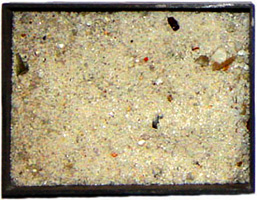
Glass sand Important deposits of glass sand of the country are at Balijuri (0.64 million ton), Shahjibazar (1.41 million ton) and Chauddagram (0.285 million ton) at or near the surface, Maddhyapara (17.25 million ton) and Barapukuria (90.0 million ton) below the surface. Glass sands consist of fine to medium, yellow to grey quartz.
White Clay There are surface to near surface deposits of white clay in Bijoypur and Gopalpur area of Netrokona district, Nalitabari of Sherpur district, Haidgaon of Chittagong district and Baitul Izzat of Satkania upazila, Chittagong district. Besides there are subsurface deposits of white clay' in Maddhyapara, Barapukuria, Dighipara of Dinajpur district and Patnitala of Naogaon district. The exposed white clay is not good in quality. It is used in the ceramic factories of Bangladesh after mixing with high quality imported clay.
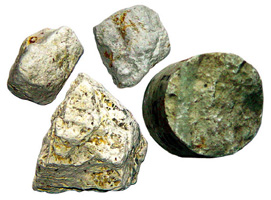
Beach sand Deposits of beach sand have been identified in the coastal belt and in the coastal islands of Bangladesh. Different heavy minerals and their reserves (in ton) are: Zircon (158,117), Rutile (70,274), Ilmenite (1,025,558), Leucoxene (96,709), Kyanite (90,745), Garnet (222,761), Magnetite (80,599) and Monazite (17,352). An Australian company has applied for the permission to carry out the feasibility study for exploitation.
Brick Clay In Bangladesh the mineralogical, chemical and engineering properties of Pleistocene and Holocene brick clays of Dhaka, Narayanganj and Narsingdi districts are well documented. The bulk chemistry and engineering properties of the Holocene and Pleistocene samples have been found satisfactory for manufacturing good quality bricks. These are being exploited and widely used in the country. [AKM Khorshed Alam and Sifatul Quader Chowdhury]
Mines Mining process of extracting coal, ores, precious stones, hardrock etc from mines. In 1774, mining was first started in undivided Bengal at Raniganj coalfield of West Bengal in India. Then Jharia, Bokrao and Karanpura coalfields of India also came under mining. From 1857 to 1957 a number of geologists expressed with the hope that coalmines would be found under the green cropped land in Bangladesh. In spite of this the then East Pakistan (now Bangladesh) was neglected for the exploration works for mineral resources. But the hopes of the geologists were vindicated when in course of searching for oil in 1959 STANVAC drilled a hole in Bogra district, where Gondwana coal was encountered at a depth of 2381m from surface. In 1985 coalfield was discovered at Barapukuria in Dinajpur district. More coalfields were discovered at Khalaspir (Rangpur district) in 1989, at Dighipara (Dinajpur district) in 1995 and at Phulbari of the same district in 1997. A large deposit of granodiorite, quartz diorite, gneiss of Precambrian age has been discovered at depth ranging from 132 to 160m below surface at Maddhyapara, Dinajpur in 1974-75.
Mine hazard Irrespective of the choice of mining methods some disturbances to the mine site and its surrounding environment are inevitable. Issues of safety and environmental concerns for mines under construction in Bangladesh are water pollution and control of mine drainage, sedimentation in water courses, noise pollution, ground vibration, air pollution, socio-economic disturbances, loss of agricultural land, danger of land subsidence, hazards of mine fire, problems of dust and human discomfort.
History of large-scale mining of minerals using modern technology and management in Bangladesh is not old. Although there are technical requirements for mine planning and hazard assessment but in small-scale sand, beach sand, glass sand, white clay, gravel, and soil mining hardly follow any standard regulations both from mine safety and environmental protection point of view.
Both from Barapukuria and Maddhyapara mine water is discharged to the surrounding paddy fields and watercourses without being treated. This practice causes serious threat to the environment as the mine water may be acidic and generally contains lot of sediments which ultimately contaminate the surface water and soil. The polluted mine water may contain pyrite and other sulphide minerals which form sulphuric acid. Ash in the coal contains silica and aluminium oxide, which are soluble in mine water. Also mine water may contain a lot of dissolved metals like iron, manganese, suspended solids, some oil and often ammonia resulting from the use of ammonium nitrate based explosives. High concentration of mine pollutants can create considerable ecological problems, as plant life is very much sensitive to sulphur dioxide even at a low concentration. As far as the Bangladesh Environmental Quality control is concerned standard pH content of surface water should not cross the limit of 6.5-8.5 to keep the water usable for drinking, irrigation, fisheries, industrial and recreational purposes. Therefore, baseline data need to be collected from the locality to define the tolerance level of ambient water bodies surrounding the mines before indiscriminate discharge of mine water.
On 5 April 1998 Barapukuria Coal Mine faced a major set back of sudden water inrush at a rate of 600-800 cu m/hour. The accident took place soon after the blasting operation was carried out in order to develop underground roadway. A large chunk of roof rock collapsed as a result of sudden inrush of water from upper lying strata at a huge rate which could not be controlled by the Chinese contractor engaged in mine building there using available means of support at Barapukuria. After the accident the mine remained inundated for few months until additional high capacity pumps were mobilised to pump out huge water accumulated in the mine. Currently Barapukuria mine has been pumping out water from underground at a rate of 350-450 cu m/hour to keep the mine prevented from further inundation. No underground work could proceed after the accident. Now after completion of 35% of mine construction works and approximately 3 km of underground roadways of the planned 12 km for Barapukuria mine, the authority was compelled to start redesigning of the mine plan due to the accident. The redesigning of the mine may significantly delay the completion of mine construction works and will squeeze the recoverable resource area and finally will escalate the production cost of coal from the mine. It is worked out that 1200-1800 cu m of water per hour will be discharged from Barapukuria once the mine building is completed and hence the pumping process needs to be continued.
Dust and mine gases create problems for coal mine. Fortunately Barapukuria coal has insignificant gas content, therefore, in the process of mining of coal the danger of methane emission and methane gas related hazards are considered to be insignificant. At Barapukuria as the coal will be mined mechanically, huge coal dusts would be generated but proper mitigation measures if taken coal dust could be controlled. Huge dusts will be generated in the Barapukuria and Maddhyapara mine areas due to frequent movements of heavy vehicles together with required loading and unloading operations. The mine air pollution is a major issue of concern. The gases formed by the combustion of coal, fuel and lubricants in the mine both at the surface and underground pollute the ambient air. Dusts generated from coal and hard rocks especially during cutting, blasting, crashing and transportation in the mines are generally the cause of concern for the miners and for the surrounding localities.
Barapukuria coal is classified as 'medium risk' category as to its spontaneous combustion potential. Spontaneous combustion of coal is a voluntary process in the mine in which coal combines with oxygen in air resulting in the release of heat and light and produces toxic gases like carbon dioxides, carbon monoxides and vapours. If such spontaneous combustion takes place at Barapukuria mine it may cause serious danger to the total safety of the mine and its environment.
The existing mining method proposed for Barapukuria aimed at coal extraction from the average 36-m thick coal seam VI. It is not clear how subsidence possibilities will be prevented in the void spaces beneath the surface. The presence of more than 100m of unconsolidated Tertiary sandy aquifers (Dupi Tila) over the coal seams may cause potential problem for subsidence once large void spaces will be left without stowing. The surface subsidence occurs due to the abstraction of water, mineral or natural gas from the ground and also removal of deep lying mineral body may cause subsidence over a wider area. Without stowing if large voids are left in the mine in the process of coal mining at Barapukuria that may trigger uncontrolled land subsidence and may cause to environmental disaster to the surrounding areas.
Large numbers of explosives are being used in both Barapukuria and Maddhyapara mines for roadway headings and underground development works initiating significant vibration in the mine and to the adjacent areas. 2,670 kg of explosives are planned to be used at Maddhyapara Hardrock Mine to secure production of 5,500 ton/day. Regular blasting operations in the mine may cause damage to old structures on the surface close to mining area. In addition to the noise and vibration caused by explosives and blasting operations in the mines, movements of heavy vehicles, bulldozers, dump trucks and other machinery will pose constant noise problems in the mine areas.
Both Barapukuria and Maddhyapara mines require to conduct Environmental Impact Studies as the Environmental Conservation Rules 1997 stipulates that all mining projects belong to 'Red Category' industries. Therefore, both the mining authorities need to prepare Environmental Impact Study Report, Environmental Management Plan, Plan for Waste Disposal along with other documents for obtaining environmental clearance from the Department of Environment of the government of Bangladesh. At the same time the mining authority needs to establish regular control for water, air, soil quality for the areas. [Mushfiqur Rahman]
See also beach sand heavy mineral; coal; gas, natural; hardrock; hydrocarbon exploration.
